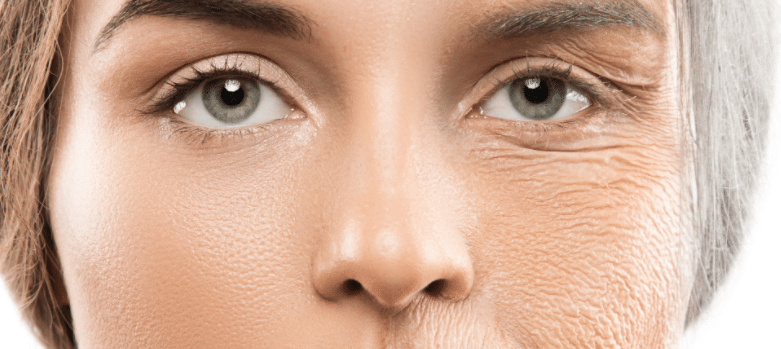How to Prevent and Reduce Fine Lines?
| What are fine lines?
Fine lines are often one of the very first signs of aging. As skin begins to age, fine lines may begin to appear around the eyes and other areas on the face. These shallow lines tend to form along expression lines that appear when you smile, laugh or frown.
| What is the difference between fine lines and wrinkles?
The only real difference between fine lines and wrinkles is the depth of the crease. Fine lines are shallower than wrinkles but may progress to wrinkles over time. A fine line forms when the skin creases—generally as a natural part of forming a facial expression. Over time, repetitive movements of your facial muscles can make these lines permanent. This inability of your skin to bounce back like it did when you were younger is a natural (if not very welcome) process caused by a breakdown in elastin and collagen production.
| What causes fine lines?
Wrinkles and fine lines on the face are one of the most visible signs of ageing. They’re caused by the breakdown of collagen and elastin in the skin – as we age, our bodies can’t produce enough collagen to replenish what has been lost, so the skin begins to lose its strength and elasticity over time.
We may not enjoy the process, but it’s normal. Unfortunately, there are factors that may accelerate this process, causing fine lines to form even earlier. Environmental factors and habits like smoking may speed skin aging, but sun damage is the biggest external factor. The ultraviolet (UV) part of the sun’s rays causes the breakdown of the elastin and collagen fibers, leading to photo damage and premature aging.
| How to prevent fine lines and wrinkles?
-
Protect Yourself From The Sun
According to studies, exposure to UV rays of the sun is responsible for around 80% of the premature signs of skin ageing, sun protection can help slow down the signs of sun damage.
-
Beauty Sleep
When you don’t get enough sleep, the body produces excess cortisol, a hormone that breaks down skin cells. Get enough rest and you’ll produce more HGH (human growth hormone), which helps skin remain thick, more “elastic,” and less likely to wrinkle.
-
Eat More Fruits And Vegetables
The key is their antioxidant compounds. These compounds fight damage caused by free radicals (unstable molecules that can damage cells), which in turn helps skin look younger and more radiant, and protects against some effects of photo aging.
-
Don’t Smoke
More and more studies are confirming that cigarette smoke ages skin — mostly by releasing an enzyme that breaks down collagen and elastin, important components of the skin.
| How To Deal With Already Existing Fine Lines And Wrinkles?
You can’t turn back time and stop or reverse the ageing process, but you can help reduce the look of fine lines and wrinkles. We have collected some useful tips and tricks you can try for your healthy-looking, supple skin.
-
Apply Moisturizer
Women, especially, are so concerned with antiaging products they often overlook the power of a simple moisturizer. Skin that is moist simply looks better, so lines and creases are far less noticeable
-
Retinoids
The only FDA-approved topical treatment for wrinkles is tretinoin, known commercially as Retin A. Ashinoff says this prescription cream reduces fine lines and large wrinkles, and repairs sun damage. Retinol is a natural form of vitamin A found in many over-the-counter products. Studies show that in a stabilized formula, in high concentrations, it may be as effective as Retin A, without the side effects, such as skin burning and sensitivity.
-
AHAs
AHAs are known for their anti-aging effects, and surface lines are no exception. One 2015 study reported that 9 out of 10 volunteers who used AHAs over a three-week period experienced significant improvements in overall skin texture.
-
Topical vitamin C
Vitamin C serums can help reduce premature aging by protecting the skin from the untimely skin wrinkles that sun exposure can cause. Vitamin C also helps reduce premature wrinkling by stimulating the growth of collagen.
-
Botox
An injection of this purified version of the Botulinum toxin A relaxes the muscle just underneath the wrinkle, allowing the skin on top to lie smooth and crease-free.
-
Wrinkle fillers
Doctors fill wrinkles with a variety of substances, including collagen, hyaluronic acid, and other synthetic compounds. Popular treatments include Restylane, Juvederm, and ArteFill, among others.
-
Laser/light resurfacing
Here, energy from a light source — either a laser or a pulsed diode light — removes the top layer of skin, causing a slight but unnoticeable skin “wounding.” This kicks the skin’s natural collagen-production system into high gear, resulting in smoother, more wrinkle-free skin.
-
Chemical peels
In this treatment, one of a variety of different chemicals is used to “burn” away the top layer of skin, creating damage that causes the body to respond by making more collagen. You end up with younger-looking, smoother skin.
-
Dermabrasion
A vacuum suction device used in tandem with a mild chemical crystal, dermabrasion helps remove the top layer of skin cells and bring new, more evenly textured skin to the surface. In the process, fine lines and wrinkles seem to disappear.


